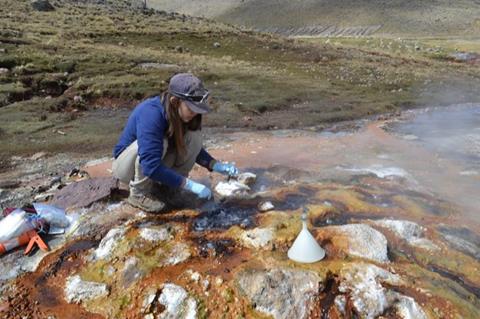Utah State University geoscientists, along with colleagues from Montana State University, examined 14 hot springs within the southern Andes in Peru and discovered microbial community composition is distinctly different in two tectonic settings.

South America’s Andes Mountains, the world’s longest mountain range and home to some of the planet’s highest peaks, feature thousands of hot springs. Driven by plate tectonics and fueled by hot rock and fluids, these thermal discharges vary widely in geochemistry and microbial diversity.
Dennis Newell, associate professor in USU’s Department of Geosciences, and recent USU graduate Heather Upin, MS 2020, report their findings in Nature’s Communications Earth & Environment. Their research is supported by the National Science Foundation and the Geological Society of America.
Tectonic influence
“We know tectonic processes control hot spring temperature and geochemistry, yet how this, in turn, shapes microbial community composition is poorly understood,” says Newell, USU Geosciences graduate director.
The scientists collected geochemical and 16S ribosomal RNA gene sequencing data from hot springs in regions with contrasting styles of subduction — flat-slab and back-arc — and noted similarities in pH but found differences in geochemistry and microbiology.
“Flat-slab hot springs were chemically heterogeneous, had modest surface temperatures and were dominated by members of the metabolically diverse phylum Proteobacteria,” Newell says.
Contrasting make-up
In contrast, the back-arc hot springs were more geochemically homogenous, had hotter water, exhibited high concentrations of dissolved metals and gases, and were home to heat-loving archaeal and bacterial organisms.
“These results tell us tectonics matter when it comes microbial community make-up, but little research has been conducted around the world to demonstrate this,” Newell says.
Further investigation, with efficient genomic research, at sites around the globe could reveal how microbes have evolved in tectonically diverse environments, he says.







No comments yet